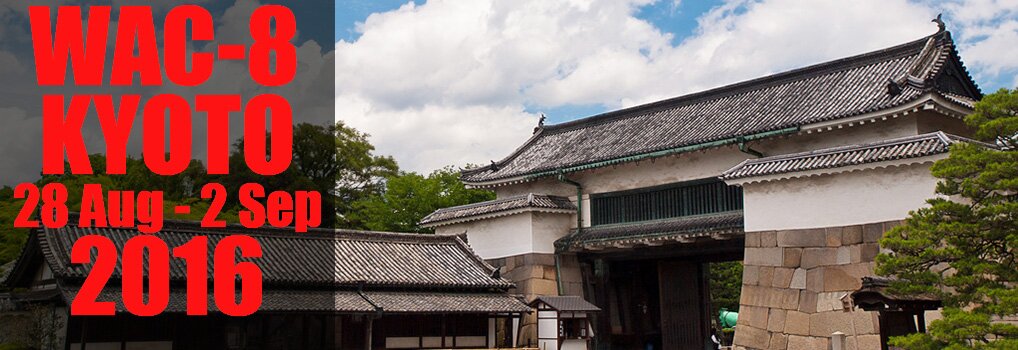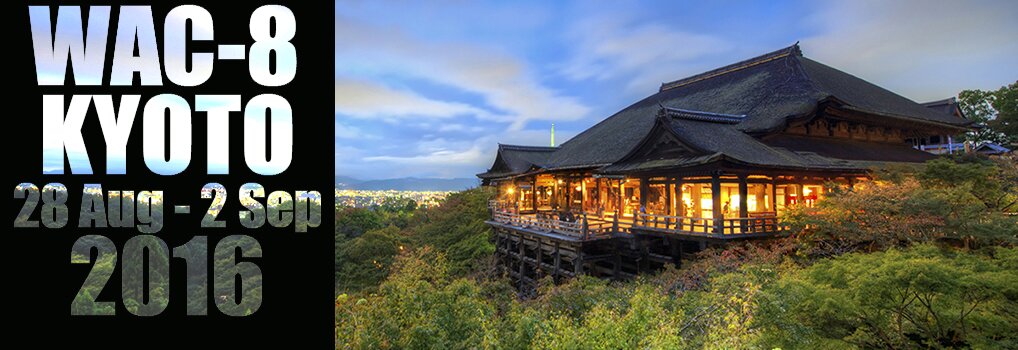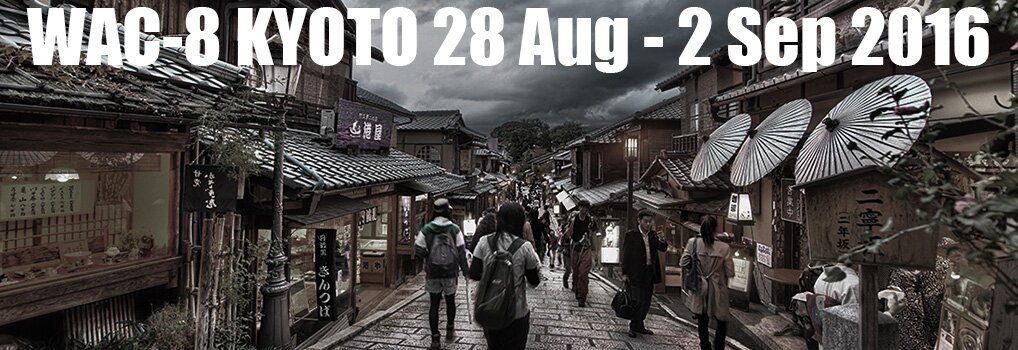One-day Free Tours / 31st Aug
SOLD OUT
Free tour 1: Kyoto National Museum and Nishijin Textile Center


Kyoto National Museum

Kyoto University
Course: Kyoto National Museum, Lunch around Kyoto University, Kyoto University Museum and Kimono show at Nishijin Textile Center.
Meeting time / place: 8:00am at Ryoshinkan, Doshisha Universsty
Date & Time: 31st Aug 8:30-16:15
Transportation: Bus
Leader(s):
Cost: Free of charge for WAC8 participants
Passenger capacity: 40
Kyoto National Museum is one of four national museums. It was established in 1897 as the Imperial Museum of Kyoto. About 6,000 works such as paintings, works of calligraphy, handicrafts and archaeological materials are on displayed in this museum.
There are over 2.5 million objects relating to the arts, sciences and education which Kyoto University has collected and studied over the past one hundred years. The museum exhibitions consist of collections relating to natural history, technological history and cultural history, including archaeological materials.
Nishijin is one of Japan’s traditional textile manufacturers whose origin goes back to the 16th Century. In the Nishijin Textile Center, you can view historical documents relating to this textile and watch a Kimono Show.
SOLD OUT
Free tour 2: Sake Brewery Museum and Emperor Meiji Mausoleum


Kyoto National Museum

Fushimi-Momoyama (Emperor Meiji) Mausoleum
Course: Kyoto National Museum, Seeing excavaton site of Shiduki Catsle ruins, Fushimi-Momoyama (Emperor Meiji) Mausoleum and Gekkeikan Okura Sake Museum
Meeting time / place: 8:00am at Ryoshinkan, Doshisha Universsty
Date & Time: 31st Aug 8:30-16:00
Transportation: Bus
Leader(s):
Cost: Free of charge for WAC8 participants
Passenger capacity: 40

Gekkeikan Okura Sake Brewery Museum
Kyoto National Museum is one of four national museums. It was established in 1897 as the Imperial Museum of Kyoto. About 6,000 works such as paintings, works of calligraphy, handicrafts and archaeological materials are on display in this museum.
Shiduki Castle was originally built by Toyotomi Hideyoshi as his own residence after retirement in 1592, but was converted into a castle in 1594. It was destroyed by an earthquake in 1596, and a new castle was built about 500 meters away on Mt. Kohata (Kohata Castle).
When Emperor Meiji died in 1912, his mausoleum was built on the ruin of Fushimi Castle (Kohata Castle). It was a mounded tomb having a dome-shaped knoll on a square base. The form of this mound was based on an imperial tomb of the 7th Century.
Gekkeikan Okura Sake Brewery Museum is housed in an old sake brewery that was built in1909, and presents the history of sake production in Fushimi. About 400 sake items are displayed. You can taste three kinds of sake in the lobby, and get sake as a souvenir.
SOLD OUT
Free tour 3: Nijo Catsle, Kitano Shrine and Arashiyama area


Nijo Castle

Kitano Tenmangu Shrine

Arashiyama
Course: Nijo Catsle, Kitano Tenmangu Shrine, Lunch and stroll around Arashiyama area
Meeting time / place: 8:30am at Ryoshinkan, Doshisha Universsty
Date & Time: 31st Aug 9:00-16:15
Transportation: Bus
Leader(s):
Cost: Free of charge for WAC8 participants
Passenger capacity: 40
Nijo Castle was originally built in 1603 to be the official Kyoto residence of the first Tokugawa Shogun Ieyasu. It was completed in 1626 by the third Shogun, Iemitsu. It consists of two concentric rings of fortifications, the Ninomaru Palace, the ruins of the Honmaru Palace, various support buildings, and several gardens.
Kitano Tenmangu Shrine was first built in 947 to appease the angry spirit of bureaucrat, scholar and poet Sugawara no Michizane, who had been exiled as a result of political maneuvering. The current buildings were constructed in 1607. The main shrine and the hall of worship are connected by the ‘Ishi-no-ma’ hall. The roofs of the three buildings are combined into a large elegant roof.
Arashiyama is a district on the western outskirts of Kyoto, and was a place of villa built for nobles in the Heian Period (). There are many places of scenic beauty and historical spots such as Togetsu-kyo Bridge and Tenruji Temple.
SOLD OUT
Free tour 4: Kyoto Gyoen National Garden and Otsu City Museum of History


Kyoto Gyoen National Garden

Otsu City Museum of History

Course: Kyoto Gyoen National Garden and Otsu City Museum of History
Meeting time / place: 11:15am at Ryoshinkan, Doshisha Universsty
Date & Time: 31st Aug 11:45-16:15
Transportation: Bus
Leader(s):
Cost: Free of charge for WAC8 participants
Passenger capacity: 40 or 80
Note: No lunch time hours
Kyoto Gyoen National Garden is the national garden which spreads 1.3km north to south and 0.7km east to west, and was the Court Nobles Residential Area in the Edo Period (1). There are famous historical spots in the garden, including Kyoto Imperial Palace.
The feature exhibition entitled “The latest archaeological discoveries in Japan”, which is sponsored by the Agency for Cultural Affairs, will be held at Otsu City Museum of History. This exhibition will display the notable artifacts which were unearthed during recent excavations in various parts of Japan.




